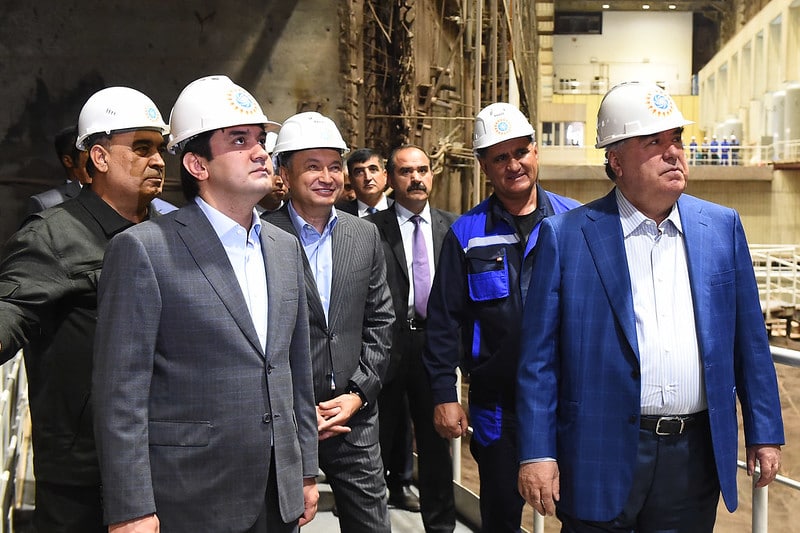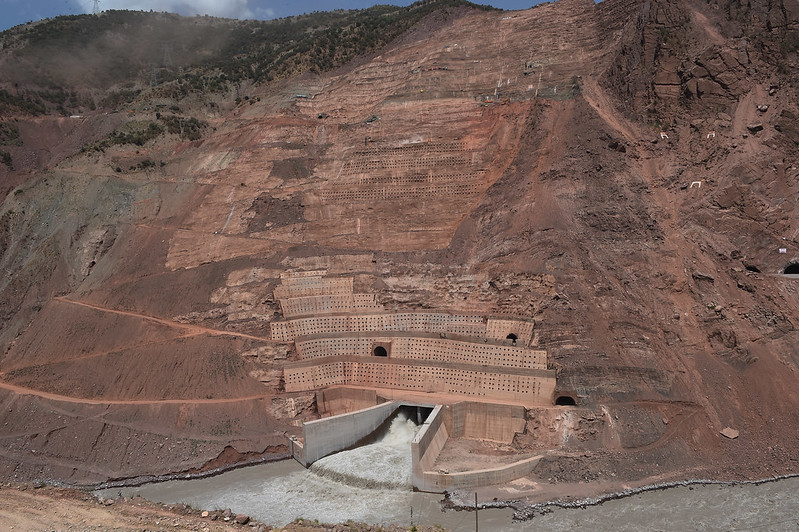Giving a news conference on the results of work carried out over the first six months of this year, Economic Development and Trade Minister Zavqi Zavqizoda told reporters in Dushanbe on July 14 that many development partners of the Government of Tajikistan have expressed interest in further implementation of the Roghun Hydropower Project.
According to him, the project financing opportunities were discussed at a meeting of the government with development partners that took place in December last year and “these works are coordinated by the World Bank at the request of the Government of Tajikistan.”
The minister, in particular, emphasized that the amount required for completion of the construction of the Roghun hydropower plant is being determined, and “after that, each development partner will consider its ability to finance the project.”
Zavqizoda further added no negotiations were carried out with any separate country.
Meanwhile, during his visit to the site for construction of the Roghun hydropower plant on July 13, President Emomali Rahmon expressed confidence that the work on attracting funds for completion of the construction of the Roghun hydropower plant will be finished before the end of this year.

He noted that specialists from the World Bank had visited the site for construction of the Roghun hydropower plant and conducted the necessary additional surveys
Meanwhile, information on specific donors and specific amounts still remains available.
Representatives of the Asian Development Bank (ADB) and the European Bank for Reconstruction and Development (EBRD) had previously spoked to Asia-Plus of their interest in financing the Roghun hydropower project.
According to the preliminary estimates, US$5 billion are needed for completion of the construction of the Roghun hydropower plant, but the cost of such large and long-term projects may change over the years.
When the Roghun project was launched in 2008, its cost was estimated at US$3 billion. Then in 2016, it was announced during the international tender that the cost of the project is US$3.9.
Now, according to data from the Ministry of Energy and Water Resources (MoEWR), US$5 billion are needed for completion of the construction of the plant. The ministry has explained the increase in the cost of the project by reassessing the cost of some works carried out at the Roghun site, inflation and the decrease in the purchasing power of the U.S. dollar.
The First Deputy Minister of Energy and Water Resources, Jamshed Shoimzoda told reporters in Dushanbe on July 12 that the issue of attracting investments from the European Union (EU) for completion of construction of the Roghun hydroelectric power plant (HPP) is still at the stage of negotiations. According to him, the Government of Tajikistan is conducting negotiations with the European Union on attracting financial resources for construction of the Roghun HPP.
It is too early to talk about any specific amount as the negotiation process is not over yet, Tajik official noted. Along with the European Union, negotiations are also underway with other donors, including the World Bank, Shoimzoda said. According to him, Shoimzoda further added that Tajikistan had signed memoranda with Kazakhstan and Uzbekistan on the supply of electricity generated by the Roghun HPP to those countries.
The fact is that one of the unresolved issues that hinders attraction of funds from international financial institutions is lack of a specific market for sale of electricity generated by the Roghun HPP.
Afghanistan and Pakistan were considered as the main markets for sale of electric power generated by the Roghun HPP. But after the Taliban's return to power in Afghanistan in August last year, the supply of Tajik electricity via CASA 1000 electricity transmission line raises certain questions.
Recall, Reuters reported on July 6 that the EU plans to become the top investor in the world’s tallest dam in Tajikistan in a move aimed at helping Central Asia cut its reliance on Russian energy and part of EU’s answer to China’s Belt and Road Initiative.
The EU’s investment arm, the European Investment Bank (EIB), has so far not funded the project, whose main developer is Italian construction firm Webuild.
But an EIB spokesman reportedly told Reuters last week that the Bank has now been asked by the European Commission to become “the largest investor” in the project.
Tajik Minister of Energy and Water Resources Daler Juma reportedly told Reuters last month that Roghun is expected to cost around US$8 billion, of which US$3 billion have already been spent. While it has been largely financed by Tajik government’s bonds and private loans up to now, the government in Dushanbe has requested EU financial and technological support in completing the project, an EU official familiar with the talks said, according to Reuters.
The EIB spokesman reportedly said the Bank was considering a joint investment with the European Commission, which controls the EU multi-billion-euro budget and like the EIB can also raise money in the markets. The EU executive confirmed that the bloc was open to finance the hydropower Roghun dam project.
He declined to comment on the size of the possible investment and on the reasons for the new commitment, according to Reuters.
Meanwhile, the EU official, who declined to be named because was not authorized to speak to media, told Reuters that a key reason for the EU to become a top investor in the hydropower dam was to make Tajikistan and its neighbors independent from Russian energy.
The EU official was cited as saying that the funding would be part of the EU’s “Global Gateway” strategy.
It is unclear when the EU’s plans could turn into actual investments, but the EU official said that decision could be made by the final quarter of this year.
Brussels and its Western allies have been trying to isolate Russia in response to the so-called “special military operation” launched by Russia in Ukraine on February 24.

The Roghun HPP is an embankment dam in the preliminary stages of construction on the Vakhsh River in southern Tajikistan. It is one of the planned hydroelectric power plants of Vakhsh Cascade.
The Roghun HPP was first proposed in 1959 and a technical scheme was developed by 1965. Construction began in 1976 but the project was frozen after the collapse of the Soviet Union.
An agreement on finishing the construction was signed between Tajikistan and Russia in 1994; however, as the agreement was not implemented, it was denounced by Tajikistan parliament.
In October 2004, Tajikistan signed an agreement with Russia's RusAl aluminum company, according to which RusAl agreed to complete the Roghun facility and rebuild the Tursunzoda aluminum smelter. In August 2007, Tajikistan formally revoked a contract with RusAl, accusing it of failing to fulfill the contract.
In April 2008, Tajikistan founded OJSC NBO Roghun for completing the construction of the Roghun HPP.
To raise funds to complete construction of the Roghun HPP the government started to sell shares in Roghun to people on January 6, 2010. Tajikistan has reportedly issued 6 billion somonis worth of Roghun shares.
In 2016, construction duties on Roghun were assigned to Italian company Salini Impregilo (currently Webuild).
The project is broken down into four components, with the most expensive one involving the building of a 335-meter-high clay core rockfill dam — the tallest in the world — which will entail costs of around $1.95 billion. Construction of the Roghun hydropower plant is expected to be completed in 2033.
Two of the six turbines have already started producing energy for sale to raise funding to complete it. The first turbine went into service in November 2018 and the second one was introduced into operation in September 2019.
According to data from the Ministry of Finance of Tajikistan (MoF), 37.7 billion somonis have been spent for construction of this hydropower plant since 2008.
If built as planned, the Roghun hydropower plant is expected to end chronic power shortages in Tajikistan and allow it to export electricity to neighboring countries.






